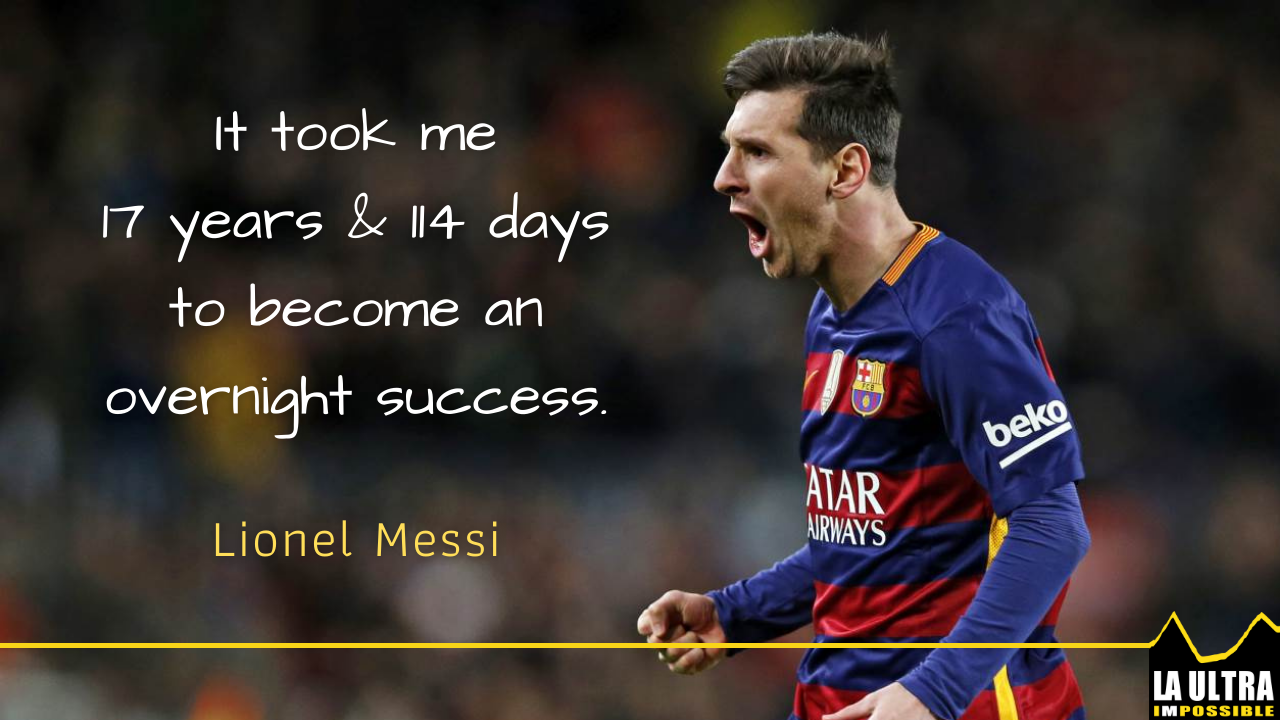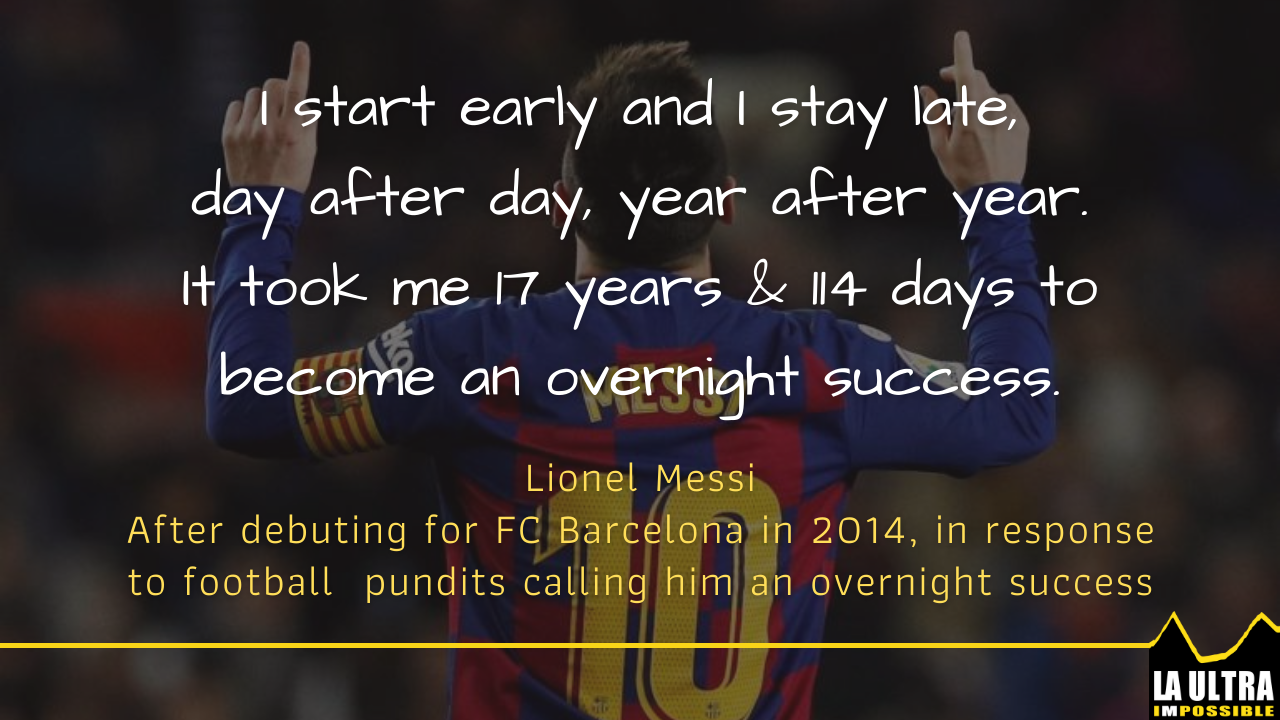Decoding the facts behind the Much-Hyped HIIT
While both HIIT and HIT are all the craze right now, it is important to understand why people move the way they do and the psychology of movement, which makes people choose this form of exercise over others.
This was first published in Hindustan Times Premium on 3rd September 2022. You need subscription to read there, i.e. it’s paid. I've put it on my blog here only after 4 weeks.
A Messi affair
People see and quote this without knowing the context and what it meant. Hence, read it again. Let it sink in.
“It took me 17 years and 114 days to become an overnight success.”
On October 16, 2004, Lionel Messi played his first official match for Football Club (FC) Barcelona. Aged 17 years and 114 days, he came on as a substitute for Barcelona in the 82nd minute and mesmerised everyone, as he has done ever since, when he’s on the field.
As much as we may grumble about today’s generation's need for instant gratification, we’ve understood this for ages, definitely far more so since the speed of life has accelerated, courtesy of our smart gadgets. For example, even back then, a young Messi knew better than most experts; that his years of repetition and hard work would, on the field, instantly gratify scouts, agents, and fans everywhere. Behind the scenes, however, is a story of perseverance, resilience, longsightedness, and most crucially, repetition.
Photo from UnSplash by Blocks Fletcher @blocksfletcher
To each their own
As a friend recently reminded me, what sells is not what people need, but what they want. All these claims on social media, and now, even in mainstream media, cater to that audience — of people having no interest in what one's needs are. This rings true today, especially in the world of fitness and exercise.
In the last few years, high-intensity interval training (HIIT) has become really popular. As the name suggests, it means doing four-seven repeats of short bursts of movements (including cycling and running sprints) lasting around 30 seconds, with four (or so) minutes of recovery. Or some version of it.
I started doing my version of HIIT way back in 1984. And HIT by 2004.
A few months before Messi’s debut for Barcelona, I started my position in London as head of the medical department for Kieser Training, a Swiss-German chain of rehabilitation centres dealing with back and knee patients. At Kieser, I was introduced to high-intensity training (HIT), which is a wider term than HIIT, but primarily is about strength training rather than cardiovascular.
A case for HIT
Way back in the 1970s, Arthur Jones, a proud generalist, popularised HIT, which again has been catching on now in the fitness fraternity in India. It openly challenged the long hours spent in the gyms every day. Dorian Yates, one of the most successful bodybuilders of all time, who won the Mr Olympia title six consecutive times in the 1990s, attributed his success to the HIT principles of training, which he continued to develop from one of Jones’ proteges, Mike Mentzer.
We saw amazing results in our back and knee patients at Kieser Training. But every repetition of each exercise had to be closely monitored by well-trained trainers. Contrary to sprints of HIIT, in HIT the movement is slow, controlled movement, taking about 8-12 seconds for each repetition. High-intensity strength and resistance workouts last to the point of complete muscular failure, which are of short duration, done once or twice a week. A long gap is required between these extreme sessions as muscles need that time to recover and adapt in a positive way to have optimal strength gain. These sessions were supposed to be extreme, almost making the person pass out. Definitely not for everyone.
In an online paper published in August 2022, professor Panteleimon Ekkekakis, chair of the department of Kinesiology at Michigan State University, looks in detail if these extraordinary claims being made about HIIT are backed by extraordinary claims, as no less will do.
But what is Kinesiology? It is the scientific study of human body movement. In addition to that, professor Ekkekakis is an exercise psychologist, which puts him in a unique position to understand that exercise doesn’t only have physical, but also psychological benefits.
Working together
The problem in today’s scientific world is that most experts are working in silos, without being able to understand the bigger picture. They might know their own subject in depth, but just don’t have the wider knowledge of other subjects that are all interconnected. A case in point is a study done a year after Messi’s debut, which has become the cornerstone for HIIT’s magical claims. This particular study was headed by professor Gibala, a physiologist at McMaster University, one of Canada's top institutions, who just didn’t know or appreciate the role of the mind in exercising.
Working in Silos! Photo from UnSpash by Wolfgang Hasselmann @wolfgang_hasselmann
It is unfortunate that even today top scientists in the best of universities don’t acknowledge the psychology of exercising and look at the physical aspect only. Sportspeople and coaches since the gurukul era have known better.
This takes me back to the first patient we doctors see in medical schools — cadavers. They teach us an immense lot, but they are just dead. All their muscles, bones, and organs could be in tip-top shape, but they aren’t working anymore. That spark of life is simply missing. Most of us doctors then spend a lifetime treating the patients who walk in through the doors as cadavers. We subconsciously ignore that they can feel and move. Most physiologists and sports scientists understand movement, but they yet are missing out on the power of the mind and psychology.
Gibala is of the opinion that lack of time is the primary reason for failure to exercise on a regular basis, something that Jones also highlighted, but being a self-professed generalist, Jones understood the importance of habit formation and motivation even more than 70 years ago. Jones was clear that HIT wasn’t for everyone but only for highly motivated individuals. Gibala highlights that HIIT presents hope for people who are looking to do the least amount of possible work to be fit, but also acknowledges that given the extreme nature of the exercise, it is doubtful that the general population could safely or practically adopt HIIT. It is then surprising that recent researchers report the highest enjoyment for HIIT.
I did my own survey on Twitter and LinkedIn. Out of the 113 people who responded, these were the results.
Tempo runs of 30-60 min (slower than intervals, faster than long slow runs) - 16%
Repeat sprint intervals of 400m or lesser (all out sprint repeats) - 11.5%
Long slow runs >30 min (focus is only on time on feet & not on speed) - 48.5%
Ran-Dumb Run (just go by how you feel, no focus on speed, distance or any other numbers) - 24%
I did my own survey on Twitter and LinkedIn
It is repeat sprint intervals that are equivalent to HIIT. Only 11.5% enjoyed it the most, that’s the least per cent of people. After all, exercising has to be fun, more so when we desire to get people to move a lot more. Most people who exercise or play sports, do it for their "me time", to connect with their deeper selves. We need to be promoting the joy of movement rather than going the pharmaceutical route, expecting people to take in the awful-tasting pill yet again, or a painful vaccination injection.
In addition to that, being a Sports-Exercise medicine doctor, I end up seeing a lot more injuries in exercise enthusiasts who do HIT or HIIT incorrectly or under poor supervision, as compared to those who exercise at a little lesser intensity. The risks outweigh the benefits by quite a bit.
Both HIT and HIIT have their roles and some people enjoy them, including me, but it doesn’t mean that there is some magic in them, and they definitely are not for everyone. This makes one revisit Messi’s quote…
“I start early and I stay late, day after day, year after year.”
If someone still doesn’t get, they need to go out for a run right now. And before that give 100 squats and 20 pushups too.
Keep miling and smiling.
Dr Rajat Chauhan is the author of MoveMint Medicine: Your Journey to Peak Health and La Ultra: cOuch to 5, 11 & 22 kms in 100 days
He writes a weekly column, exclusively for HT Premium readers, that breaks down the science of movement and exercise.
The views expressed are personal





